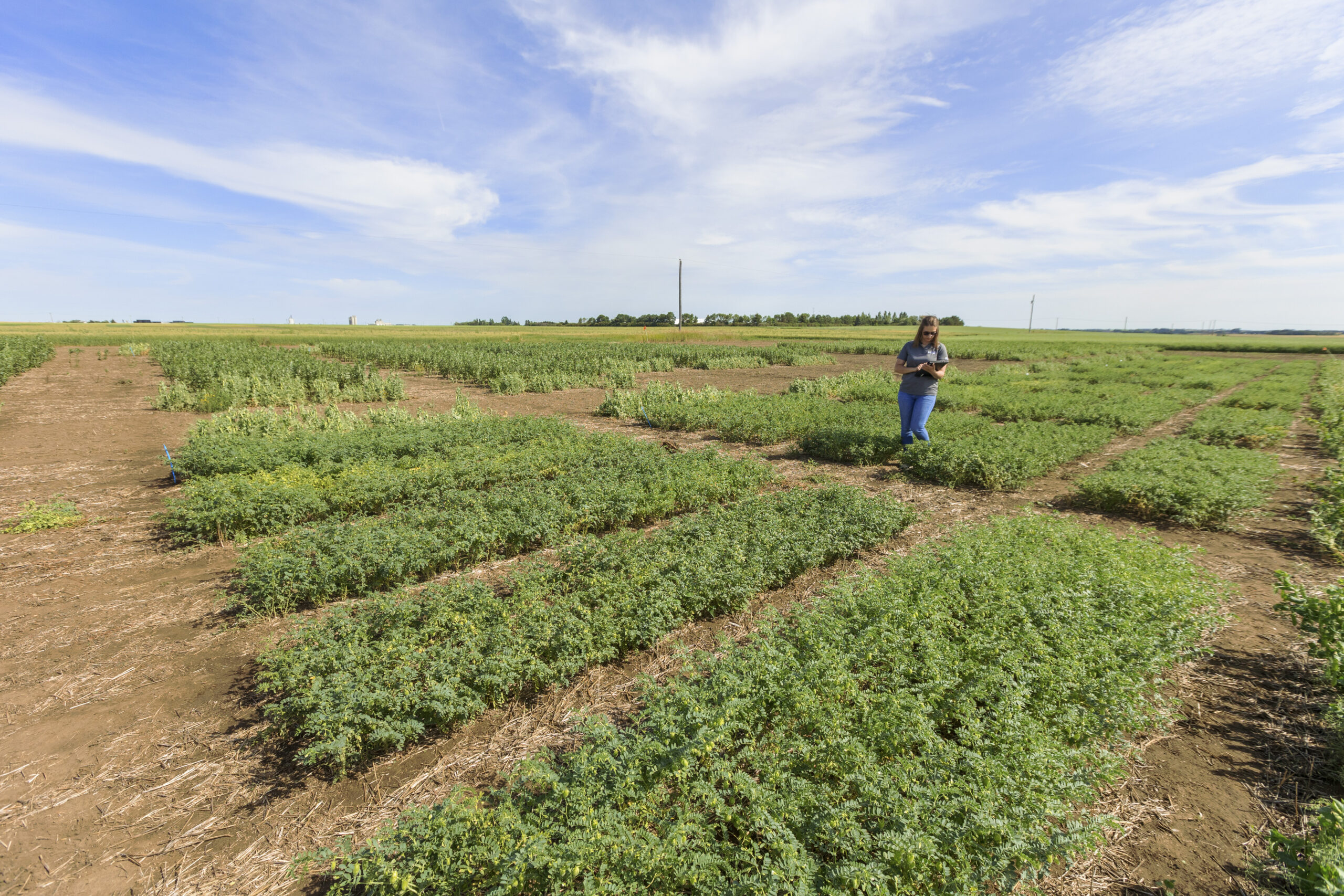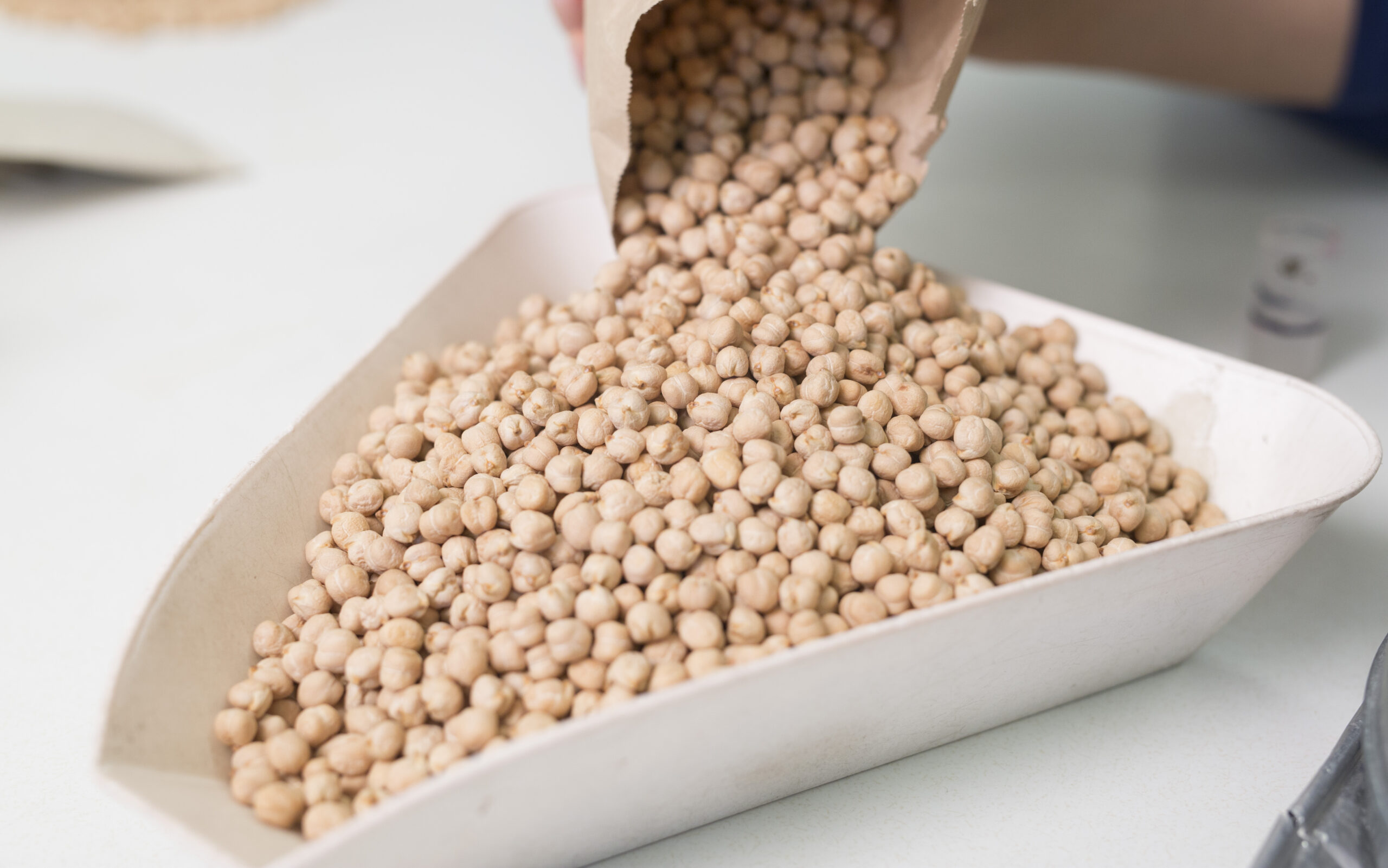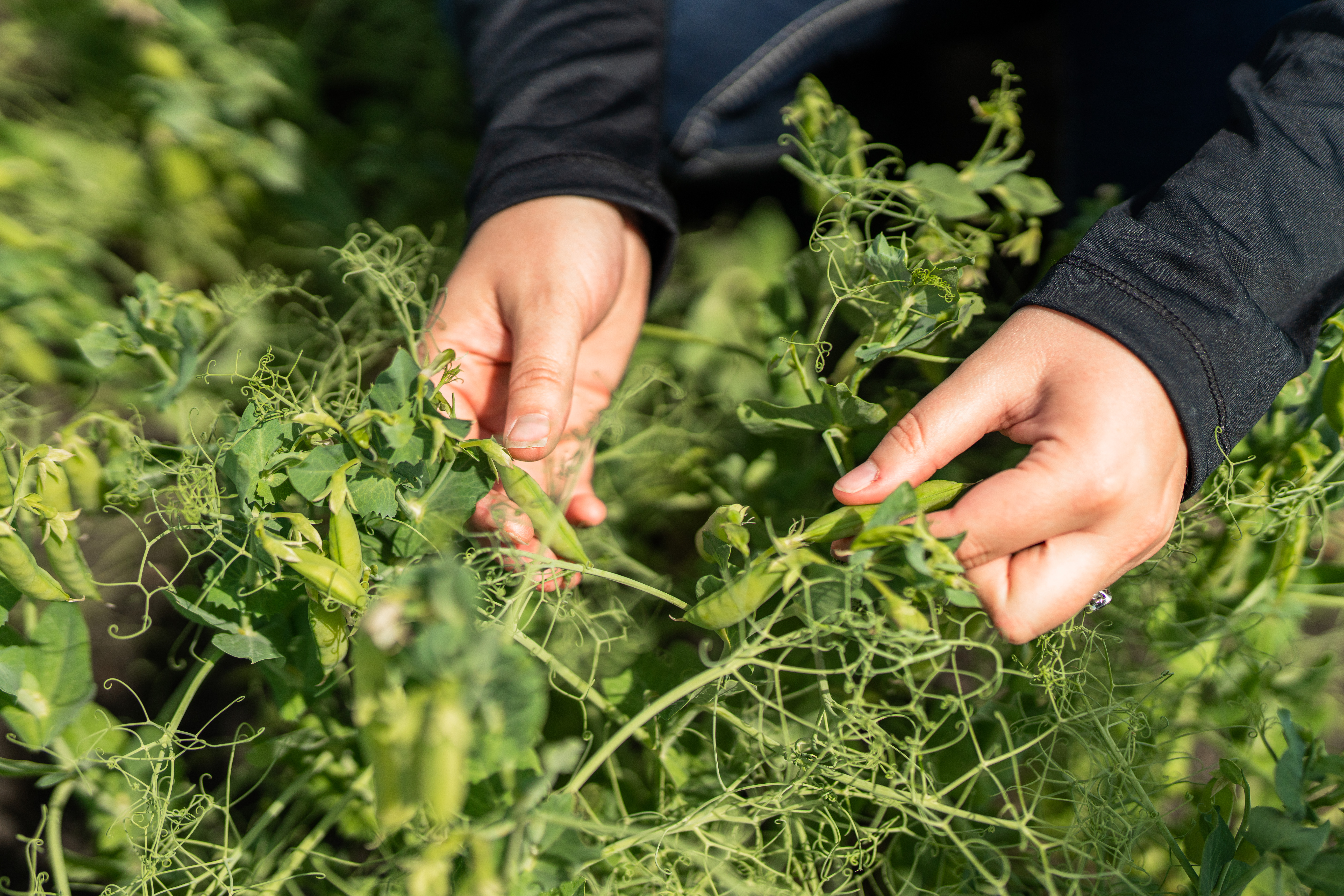Variety selection can have a significant impact on the overall profitability of pulse crops and is an important agronomic consideration for any grower. With several varieties to choose from, selecting the variety most appropriate for a specific operation is not always a straightforward decision. Before pulse varieties become commercially available, they undergo a rigorous testing process to ensure genetics hitting the field have the appropriate agronomic and market-acceptance qualifications.
Once commercially available, testing does not stop. Varieties continue to be enrolled in pulse Regional Variety Trials (RVTs) where they are compared against standard check varieties in small-plot settings using standardized protocols with results being statistically analyzed. RVT data is aggregated and published in the SaskSeed® Varieties of Grain Crops publication every year and it also compiled and available on SPG’s RVT Portal.
During the 2023 growing season, Saskatchewan Pulse Growers (SPG) conducted three Pulse Variety Showcases to demonstrate crop performance differences of commercially available pea and lentil varieties under typical field-scale conditions and management practices. Pea and lentil acres are still dominated by older varieties which have lower yield potential, and the goal of the showcase was to provide an opportunity for growers to consider options of newer, higher-yielding pea and lentil varieties.
Showcase Sites
The three Pulse Variety Showcase sites in 2023 were established in diverse regions across the province including Rosetown, Avonlea, and St. Brieux, and demonstrated 3‒7 varieties of 1‒2 market classes per crop type. Top new varieties of small red and large green lentil, and yellow and green pea were compared to leading established varieties including CDC Maxim, CDC Greenstar, CDC Meadow, and CDC Limerick. Demonstrated crops and classes differed by site with both pea and lentil being established at Avonlea, only lentil at Rosetown, and only pea at St. Brieux. Scaled to the equipment of cooperating growers, varieties were seeded in strips in commercial farm fields and were managed in alignment with standard growing practices. Single replication was conducted at Avonlea and St. Brieux with randomized, triple-replicated strip trials conducted at Rosetown. All seed sourced for these demonstrations came from Certified seed lots except for CDC Maxim at the Rosetown site which was bin-run, farm-saved seed.
Variety selection was the only management variable across trial sites and all other fertility, inoculant, weed, disease, and other pest or harvest management operations were held constant and in accordance with good agronomic practices. Speed and depth of seeding were also consistent across variety demonstration. Seeding rate was determined from a standardized target plant stand and calculated based on pea and lentil seed lot thousand kernel weight (TKW) with percent survivability standardized across all varieties (Table 1).
Table 1. Summary of lentil and pea variety treatments and estimated seeding rate based on targeted plant populations and seed test criteria of supplied seed lots.
| Crop & Class | Variety |
Targeted Plant Stand (plants ft-2) |
Germination (%) |
TKW (grams) |
Targeted Seeding Rate (lbs ac-1) |
|---|---|---|---|---|---|
| Small red lentil | CDC Maxim (Avonlea) | 12 | 94 | 44.3 | 64 |
| CDC Maxim (Rosetown) | 98 | 38.4 | 53 | ||
| CDC Simmie | 99 | 39.2 | 54 | ||
| CDC Proclaim | 97 | 43.6 | 61 | ||
| CDC Redmoon1 | 98 | 37.3 | 51 | ||
| CDC Nimble | 96 | 42.2 | 59 | ||
| CDC Impulse | 96 | 50.8 | 72 | ||
| Large green lentil | CDC Greenstar1 | 12 | 92 | 64.7 | 95 |
| CDC Lima | 96 | 69.6 | 98 | ||
| CDC Grimm | 97 | 84.0 | 117 | ||
| Green pea | CDC Limerick | 8 | 95 | 226 | 214 |
| CDC Spruce | 95 | 280 | 266 | ||
| CDC Forest | 80 | 208 | 234 | ||
| Yellow pea | CDC Meadow | 8 | 96 | 223 | 209 |
| AAC Profit | 82 | 261 | 287 | ||
| AAC Chrome | 83 | 235 | 255 | ||
| CDC Lewochko | 89 | 207 | 210 | ||
| CDC Inca | 87 | 242 | 251 | ||
| CDC Spectrum | 81 | 240 | 267 | ||
| CDC Canary2 | 90 | 230 | 230 |
1CDC Redmoon and CDC Greenstar are conventional lentil varieties and are not tolerant to imidazoline herbicide application.
2CDC Canary was only included as a variety treatment at St. Brieux due to the region’s shorter grower season and the very early maturity rating of that variety.
The Avonlea, Rosetown, and St. Brieux sites represent distinct growing regions, soil types, and environmental conditions. Soil types at the three locations were as follows: Rosetown a Regina (Dark Brown Chernozem) association heavy clay, Avonlea a Claybank (Dark Brown Chernozem/Solonetz) association loam, and St. Brieux a mixture of Yorkton (Thick Black Chernozem), Waitville (Gray Luvisol), and Whitewood (Dark Gray Chernozem) association loams (SKSIS). Lentil and pea varieties at the Avonlea site were seeded on May 15 and 16, peas at St. Brieux were seeded May 21 (CDC Canary- May 23), and lentils at Rosetown seeded May 18. Precipitation (Figure 1) was measured using either on-farm weather station data (Rosetown, St. Brieux) or a nearby Environment Canada weather station (Avonlea). Fertility at St. Brieux was applied at 150 pounds per acre (lbs/ac) of a 13-16-10-10 blend, Avonlea 12-40-0-10 1ZN at 56 lbs/ac, and Rosetown applying a variable rate fertility package based on zone prescription with an average blend analysis of 5-19-1-0.

Outcomes & Observations
It is important to note that the data collected and observations seen at these sites were based on a single season of measurement. With only single replication strip trials in Avonlea and St. Brieux, data collected at these sites can only be perceived as anecdotal. The triple-replicated and randomized strip trials at Rosetown allow us to garner a more meaningful interpretation of the yield data observed at this site. Taking that into consideration, we did see some common observations in the red lentils, with the industry standard check (CDC Maxim) being the lowest-yielding red lentil in both Avonlea and Rosetown (Figures 2 and 3) and the industry standard check in large green lentils (CDC Greenstar) also being the lowest-yielding in that market class in Avonlea (Figure 3). In the yellow peas we saw that the industry standard check (CDC Meadow) was the lowest-yielding in Avonlea (Figure 6) but ranked 4th out of 7 in at St. Brieux (Figure 7). In the green peas we saw the industry standard check (CDC Limerick) was the lowest-yielding in Avonlea (Figure 6) and 2nd out of 3 at St. Brieux (Figure 7). Average harvested plot sizes were 1.32 acres in St. Brieux, 1.2 acres in Avonlea, and 1.93 acres in Rosetown.
Lentil
The yield advantage of growing a newer small red lentil variety compared to the industry standard (CDC Maxim) was consistent at both Rosetown and Avonlea sites with every variety out-yielding CDC Maxim by 0.5 bushels per acre (bu ac-1) (CDC Simmie-Rosetown) to 6.4 bu ac-1 (CDC Redmoon-Rosetown). CDC Redmoon, CDC Nimble, and CDC Impulse were the three highest-yielding small red varieties at both Rosetown and Avonlea. The large green lentils in Avonlea saw the two newer Clearfield® varieties, CDC Lima and CDC Grimm, outyielding the industry standard and conventional CDC Greenstar by 2 and 3 bu ac-1, respectively. Harvest samples were submitted from the Rosetown site for quality analysis (Figures 4 and 5). All results came back negative for any seed-borne disease, germination and vigour levels were very high, and thousand kernel weight was similar to those found in the SaskSeed Guide.




Pea
At the Avonlea site, CDC Meadow was at a 2 bu ac-1 yield disadvantage to the next lowest-yielding yellow pea (CDC Spectrum) and gave up 7.6 bu ac-1 to the top yellow pea variety (AAC Chrome). At the St. Brieux site, CDC Meadow outyielded the lowest-yielding variety (CDC Lewochko) by 5.3 bu ac-1 but gave up 2.6 bu ac-1 to the highest-yielding variety (CDC Inca).
Both sites of green pea followed the same yield pattern with CDC Forest as the highest-yielding variety with second going to CDC Limerick in Avonlea and CDC Spruce in St. Brieux. The yield advantage of CDC Forest over the industry standard CDC Limerick was 3.2 bu ac-1 and 6.4 bu ac-1 at Avonlea and St. Brieux, respectively.





A benefit of having these types of sites with a cooperating grower is the ability to get any feedback on specific varieties during the growing season. Watching these plants from seeding to harvest, growers can note on stand, lodging, canopy closure, maturity, and harvestability that may stand out more in a side-by-side comparison. Some of the comments noted during 2023 can be found below.
Avonlea
- CDC Forest: Looked the best all year
- CDC Meadow: Noticeably earlier
- CDC Redmoon: Earlier
- CDC Simmie: Shorter
Rosetown
- CDC Proclaim: Slightly better canopy closure
- CDC Impulse: Lodged more but still able to harvest, one of three reps had yield affected due to lodging
- CDC Simmie: More chaff in harvest samples than any other variety, similar harvestability to CDC Maxim
- CDC Nimble: Cut the nicest at harvest
Next Steps
SPG’s Pulse Variety Showcase sites in 2024 will be located at Wheatland Conservation Area (WCA), Indian Head Agricultural Research Foundation (IHARF), and Western Applied Research Corporation (WARC) AgriARM sites and toured as a stop during their respective field days. Tentatively planned crops to be showcased include pea (IHARF, WARC), lentil (WCA, IHARF, WARC), faba bean (WARC, IHARF), and chickpea (WCA).
Acknowledgments
The Pulse Variety Showcase would not have been possible with the involvement of grower cooperators. Saskatchewan Pulse Growers gratefully acknowledges the cooperation of Petruic Seed Company (Avonlea, SK), SM Ag Research (St. Brieux, SK), MaxAg Consulting (Rosetown, SK), and Lawrence Farms (Rosetown, SK). Appreciation is also extended to Howard Love for seed coordination and in-season site inspections.






